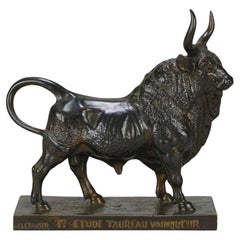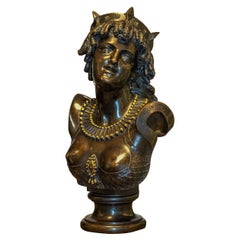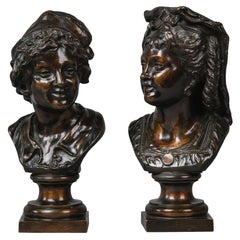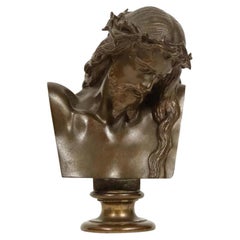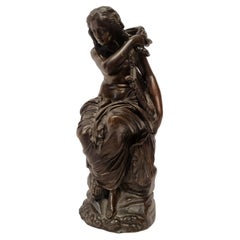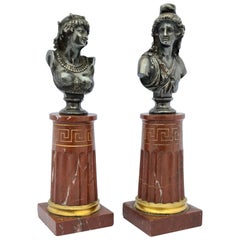Jean-Baptiste Clésinger Furniture
3
to
2
1
3
3
3
2
3
3
3
3
3
4
5,150
4,013
2,454
2,236
Creator: Jean-Baptiste Clésinger
19th Century Animalier Bronze "Taureau Vainqueur" by Jean-Baptiste Clesinger
By Jean-Baptiste Clésinger
Located in London, GB
An impressive late 19th century French bronze study of a majestic bull with standing in a proud stance exhibiting excellent hand chased surface detail and fine rich brown patina. Rai...
Category
Mid-19th Century French Art Nouveau Antique Jean-Baptiste Clésinger Furniture
Materials
Bronze
19th Century Animalier Bronze "Taureau Romano" by Jean-Baptiste Clesinger
By Jean-Baptiste Clésinger
Located in London, GB
A magnificent late 19th century French bronze study of a large bull in a proud stance, the bronze exhibiting excellent hand chased surface detail and fine rich brown patina. Raised o...
Category
19th Century French Art Nouveau Antique Jean-Baptiste Clésinger Furniture
Materials
Bronze
Finely Casted Patinated Bronze Bust Figure Entitled "Ariadne"
By Jean-Baptiste Clésinger
Located in New York, NY
Signed J. Clesinger and inscribed Maison Marnyhac/ 1 Rue de la Paix
Artist: Jean-Baptiste Clésinger (1814-1883)
Date: Early 19th century
Origin: French
Dimension: 26 x 13 1/2 X...
Category
19th Century French Antique Jean-Baptiste Clésinger Furniture
Materials
Bronze
Related Items
Pair of Patinated Bronze Busts
Located in Brighton, West Sussex
A pair of patinated bronze busts.
French, circa 1870.
Category
1870s French Antique Jean-Baptiste Clésinger Furniture
Materials
Bronze
Jean-Baptiste Auguste Clesinger, French Bronze Bust of Jesus Christ, Barbedienne
By Ferdinand Barbedienne
Located in New York, NY
An exceptional French patinated realistic miniature bronze bust of Jesus Christ, 1858
Signed: J CLESINGER. 1858 and F. BARBEDIENNE FONDEUR, wi...
Category
19th Century French Antique Jean-Baptiste Clésinger Furniture
Materials
Bronze
H 6.5 in W 3.5 in D 2.5 in
Espacio Bronze Centerpiece by Jean-Baptiste Van Den Heede
Located in Geneve, CH
Espacio bronze centerpiece by Jean-Baptiste Van den Heede
Unique piece signed and numbered
Dimensions: D 41 x 8 cm
Materials: bronze
Other sizes and materials available.
Ea...
Category
2010s Spanish Modern Jean-Baptiste Clésinger Furniture
Materials
Bronze
Antique Pair Italian Bronze Busts Dionysus and Ariadne by Clodion 18th Century
By Claude Michel Clodion
Located in London, GB
This is a fine antique pair of Italian Grand Tour solid bronze busts of Dionysus and Ariadne by Clodion, and bearing his signature, dating from the l...
Category
1790s Italian Antique Jean-Baptiste Clésinger Furniture
Materials
Bronze
H 11.03 in W 6.3 in D 5.12 in
Jean-Baptiste Auguste Clesinger, French Bronze Bust of Jesus Christ, Barbedienne
By Ferdinand Barbedienne
Located in New York, NY
An exceptional French patinated realistic bronze bust of Jesus Christ, circa 1858
Signed: J CLESINGER. & F. BARBEDIENNE FONDEUR, with the Reduction Me...
Category
19th Century French Antique Jean-Baptiste Clésinger Furniture
Materials
Bronze
H 12.5 in W 9 in D 4.5 in
Jean-Baptiste Auguste Clesinger, French Bronze Bust of Jesus Christ, Barbedienne
By Ferdinand Barbedienne
Located in New York, NY
An exceptional French patinated realistic miniature bronze bust of Jesus Christ, 1858
Signed: J CLESINGER. 1858 and F. BARBEDIENNE FONDEUR, wi...
Category
19th Century French Antique Jean-Baptiste Clésinger Furniture
Materials
Bronze
H 7.5 in W 5 in D 3 in
Fine Patinated Bronze Statue Entitled ‘AURORE’ by Auguste Moreau
By August Moreau
Located in Brighton, Sussex
A very good quality 19th century patinated bronze statue of 'Aurore', signed Aug. Moreau
Aurora, in Greco-Roman mythology, the personification of the dawn. According to the Greek poet Hesiod's Theogony, she was the daughter of the Titan Hyperion and the Titaness Theia and sister of Helios, the sun god, and Selene, the moon goddess...
Category
Late 19th Century French Greco Roman Antique Jean-Baptiste Clésinger Furniture
Materials
Bronze
Patinated Bronze Sculpture/Figure of a Frog
Located in Guaynabo, PR
This is a patinated bronze medium size sculpture of a sitting frog with its right hand in the chest (it’s heart). This gesture symbolizes dignity and hono...
Category
20th Century Unknown Modern Jean-Baptiste Clésinger Furniture
Materials
Bronze
‘Gloria Victis’, A Patinated Bronze Figural Group by Mercié, Cast by Barbedienne
By Ferdinand Barbedienne
Located in Brighton, West Sussex
A Patinated Bronze Figural Group of ‘Gloria Victis’ (‘Glory to the Vanquished’), Cast by Ferdinand Barbedienne from the Model by Marius-Jean-Antonin Mercié (French, 1845-1916).
‘Gloria Victis’ (‘Glory to the Vanquished’).
Bronze, gilt and dark brown patina.
Signed 'A. Mercié', with foundry inscription 'F. BARBEDIENNE, Fondeur. Paris.' and A. Collas reduction cachet. The integral base titled 'GLORIA VICTIS'.
This cast is part of a limited edition by the Barbedienne Foundry.
France. Circa 1880.
‘Gloria Victis’ is one of the most recognisable and important works of sculpture of the nineteenth century and a definitive image of France’s historic national identity. The figure of glory, winged and wearing armour, carries a dying young warrior heavenwards towards fame and immortality. The compositional daring of the group must be admired for balancing two figures on the minimal support of one foot, wings spread in the moment before taking flight.
Mercié was a student at the French Academy of Rome when the Prussians invaded France in 1870. Shortly after the war had begun, he executed a group depicting the figure of Fame supporting a victorious soldier. When news reached Mercié in Rome that the French had surrendered, he decided to alter his group, replacing the victorious soldier with a defeated casualty, thus transforming an allegory of ‘Glory to the Victors’ into one of ‘Glory to the Vanquished’. Completed in 1872, a year after the defeat of French soldiers against the Prussian army, the statue personifies a defeated but heroic France. The title is also a reversal of the famous formula, ‘Vae Victis’ (Death to the Vanquished), which the Gallic general Brennus exclaimed upon defeating the Romans in 390 BC. The figure of the fallen soldier was thought to represent Henri Regnault, a fellow sculptor of Mercié who was killed on the last day of fighting.
Measuring 317 cm. high the original group of ‘Gloria Victis’ was unveiled in plaster at the Salon of 1872. It was bought by the City of Paris for the sum of twelve thousand francs and then cast in bronze by Victor Thiébaut for eight thousand five hundred francs. The bronze was exhibited at the Salon in 1875 and first placed in Montholon Square in the 8th arrondissement. In 1884 it was transferred to the courtyard of the Hôtel de Ville and in 1930, it entered the collection of the Musée du Petit Palais, where it can be seen to this day.
The Thiébaut Frères foundry also cast Gloria Victis bronzes for the cities of Niort (requested 1881) Bordeaux (requested 1883), Châlons-sur-Marne (today, Châlons-en-Champagne; requested 1890), and Cholet (requested 1901). In 1905, the Danish brewer and art collector Carl Jacobsen was permitted to have an exact cast made of the original sculpture in Paris, on condition that the base was made 2 cm lower and bore the inscription “Original tilhører Paris By” (The original belongs to the City of Paris). It too was cast by the Thiébaut Frères foundry. Gloria Victis was one of Jacobsen’s most important and his last acquisition. Today it has been returned to its original position in the Winter Garden at Glyptoteket, Copenhagen, Denmark.
The full-size plaster was shown again at the Paris Expositon universelle of 1878 alongside a bronze reduction by Barbedienne. By this time Antonin Mercié had entered into a commercial edition contract with the Ferdinand Babedienne foundry to produce bronze reductions of Gloria Victis, his most famous work. Gloria Victis is first recorded to have been produced in three sizes and by 1886 Barbedienne’s ‘Catalogue des Bronzes D’Art’ lists six sizes measuring 3/5, 9/20, 7/20, 3/10, 6/25 and 2/10, of the original. These reductions were produced by an invention of Barbedienne’s business partner Achille Collas. The Collas reducing machine was a type of complex mechanical pantograph lathe that enabled sculpture to be mathematically measured and transcribed to scale, in the round, thus making a reduced size plaster from which a bronze could be cast.
Mercié's modern sculpture had become an instant classic, even receiving an entry in the Nouveau Larousse Illustré. The success of the group undoubtedly lay in the fact that it was admired not just on an aesthetic level, but also on a patriotic level, particularly in its commemoration of heroism in defeat. Immediately ‘Gloria Victis’ was recognised as a national artwork, capable of arousing patriotism and casts were ordered from Barbedienne as local memorials commemorating the war’s dead for cities across France. ‘Gloria Victis’ was considered so much a part of France’s national identity that for the 1900 Paris Exhibition, Ferdinand Barbedienne’s nephew Gustave Leblanc, loaned a bronze example to feature as part of l’Exposition centennale de l’art français.
Literature:
For an interesting account of the process of creating a reduction in bronze of the Gloria Victis by Barbedienne and illustrations of the casting and finishing of the bronze see:
'Ferdinand Barbedienne': Theodore Child; Harper's new monthly magazine, Volume 73, Issue 436, September 1886.
‘Contemporary French Sculptors’: The Century, Volume 33, Issue 3, Jan 1887.
‘Modern French Sculpture’: Harper's new monthly magazine, Volume 76, Issue 452,
January 1888.
S, Lami, ‘Dictionnaire des sculpteurs de l'Ecole française au dix-neuvième siècle’, Tome III. G.-M., Paris, 1914, p. 432.
Peter Fusco and H.W. Janson, The Romantics to Rodin: French Nineteenth Century Sculpture from North...
Category
19th Century French Antique Jean-Baptiste Clésinger Furniture
Materials
Bronze
H 41.74 in W 16.54 in D 14.18 in
Bust of Bacchante by Auguste Baptiste Clesinger, Rome, 1857
By Jean Auguste Baptiste Clesinger
Located in Vancouver, British Columbia
A large bronze bust showing a beautiful young woman depicted as a Bacchante, the Greek Goddess of Wine, her head festooned with grape branches. The bust is supported by an integral bronze plinth that at the back is inscribed with the name of the sculptor, J. Clesinger Rome 1857 dating the bronze to the time when the sculptor was 33 years old.
The sculptor whose full name was Jean Auguste Baptiste Clesinger was born in 1813 in Besancon in Southern France. His father, Georges-Philippe, was a sculptor and trained Auguste in art. Auguste first exhibited at the Paris Salon in 1843 with a bust of Vicomte Jules de Vaidahon. At the 1847 Salon, he created a sensation with his Woman bitten by a serpent, produced from life-casts from his model Apollonie Sabartier who was a notorious Parisian and the mistress of many perhaps even of Clesinger himself. Later he also produced this bust of her as Bacchante.
In private life, the sculptor was awarded one of France’s highest honour, the knight’s cross...
Category
Mid-19th Century French Romantic Antique Jean-Baptiste Clésinger Furniture
Materials
Bronze
French Bronze Ariadne After Clodion
By Claude Michel Clodion
Located in Newark, England
Signed Clodion
From our Sculpture collection, we are pleased to offer this French Belle Epoque Bronze of Ariadne cast after Clodion (Claude Michel). The sculpture of fine casting and beautiful patination is sculpted as a bust of a Ariadne in nature with her hair tied up and leaves intwined in her hair. The Bronze sits upon a circular socle with a square base signed to the right hand face Clodion. The Bronze cast after the original during the neoclassical era dating to the second half of the 19th century during the Belle Epoque era (c.1970-1914) circa 1875.
Clodion was the alias of Claude Michel (1738-1814) a French born sculptor working in the Rococo style, especially noted for his works in marble, bronze, & terracotta. Many of Clodion’s works feature in museum collections around the world with some of his most pivotal works including The Intoxication of Wine and The Dance of Time.
Ariadne In Greek mythology was a Cretan princess and the daughter of King Minos of Crete. Ariadne was known for aiding Theseus escape the Minotaur and then being abandoned by him on the island of Naxos. There, Dionysus saw Ariadne sleeping, fell in love with her, and later married her. Many versions of the myth recount Dionysus throwing Ariadne’s jewelled crown into the sky to create a constellation, the Corona Borealis...
Category
Late 19th Century French Belle Époque Antique Jean-Baptiste Clésinger Furniture
Materials
Bronze
Tibetan Patinated Bronze and Brass Buddha Bust
Located in New York, NY
Vintage Tibetan bronze figural bust of the Buddha with a natural green patina, resting on an oval polished brass plinth.
Category
20th Century Tibetan Tibetan Jean-Baptiste Clésinger Furniture
Materials
Metal, Brass, Bronze
Previously Available Items
Apollo by Auguste Clésinger, Patinated Bronze, Rome, 1857
By F. Barbedienne Foundry, Jean-Baptiste Clésinger
Located in SAINT-OUEN-SUR-SEINE, FR
Superb bronze representing Apollo by the famous French sculptor and painter Jean-Baptiste Auguste Clésinger, known as Auguste Clésinger (1814-1884). He is the son of Georges-Philippe...
Category
1850s Italian Antique Jean-Baptiste Clésinger Furniture
Materials
Bronze
Pair of Bronze Busts by Jean-Baptiste Clesinger Et Marnyhac, Paris
By Maison Marnyhac 1, Jean-Baptiste Clésinger
Located in Saint-Ouen, FR
Jean-Baptiste Clesinger (1814-1883) et MARNYHAC à Paris
A French 19th century pair of silvered bronze busts
Representing Marianne and Cleopatra, allegory of freedom and power.
Res...
Category
1860s French Louis XVI Antique Jean-Baptiste Clésinger Furniture
Materials
Marble, Bronze, Ormolu
Jean-baptiste Clésinger furniture for sale on 1stDibs.
Jean-Baptiste Clésinger furniture are available for sale on 1stDibs. These distinctive items are frequently made of metal and are designed with extraordinary care. There are many options to choose from in our collection of Jean-Baptiste Clésinger furniture, although gold editions of this piece are particularly popular. Many of the original furniture by Jean-Baptiste Clésinger were created in the Art Nouveau style in france during the 19th century. Prices for Jean-Baptiste Clésinger furniture can differ depending upon size, time period and other attributes — on 1stDibs, these items begin at $2,591 and can go as high as $12,000, while a piece like these, on average, fetch $2,656.
